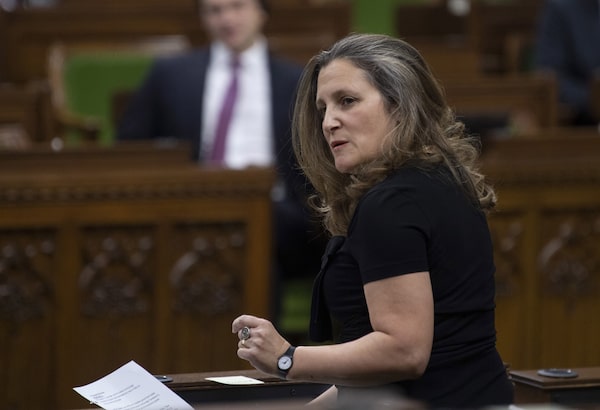
Deputy Prime Minister and Minister of Finance Chrystia Freeland responds to a question during Question Period in the House of Commons on Dec. 8, 2020 in Ottawa.Adrian Wyld/The Canadian Press
David Dodge, former governor of the Bank of Canada and deputy minister of finance, and Michael Horgan, former deputy minister of finance, are senior advisors with Bennett Jones. This article is part of the Public Policy Forum’s ReBuild Canada series and is a follow up to PPF’s Twin Deficits paper released in September.
As Chrystia Freeland makes choices in her first budget as Finance Minister, two critical markers will come immediately in view: the deficit for the next fiscal year and the fiscal track for the medium term.
The discussion about public deficits and debt globally is strikingly different today than a dozen years ago in the aftermath of the global financial crisis. Then, with the first signs of recovery, major economies were intent on returning quickly to their traditional fiscal anchors – in Canada’s case, a balanced budget.
Today the International Monetary Fund, the Organization for Economic Co-operation and Development and a number of other analysts are recommending that governments continue to maintain aggressive fiscal support for households and firms until the effects of the pandemic are clearly behind us. Governments can thus complement the action of central banks while taking advantage of historically low interest rates.
This gives the minister a fair amount of discretion over the near-term deficit and over the speed at which to taper the extraordinary pandemic spending. Yet with such discretion comes added responsibility to spend on policy choices with long-term payoffs. Austerity is not today’s responsible course. Nor is unhinged spending.
First, as observed by the OECD, there has been poor correlation globally between the size of fiscal responses to the COVID-19 crisis and the extent to which countries have contained the losses of output and jobs. It matters not only how much, but, critically, how governments spend.
According to the IMF, Canada incurred the largest overall fiscal deficit (20 per cent of gross domestic product) among major economies in 2020 – the next closest was the United States (17.5 per cent of GDP). Yet, the IMF estimates that our GDP dropped more than the average of advanced economies, and that our bounceback this year will be less than the average. So we can do better in translating spending into growth.
Second, while interest rates are low, there is a significant risk that too large a fiscal stimulus could reignite inflationary expectations and push interest rates up. Former U.S. treasury secretary Larry Summers has offered this note of caution for the proposed U.S. stimulus package.
Indeed in an uncertain world, it is important to give the buyers of government debt reasons to feel confident that the asset they will purchase will preserve its real value. The minister can bolster the confidence of markets in Canada’s credit by choosing one or more anchors that will guide the government in its fiscal choices and set a medium-term fiscal track that is sustainable.
In the Bennett Jones Fall 2020 Economic Outlook, we suggested a “10 per cent rule” as fiscal anchor for the medium term – ensuring that in the future debt service charges absorb no more than 10 per cent of government revenue. Admittedly, there is nothing magical about 10 per cent as a number, but it is reasonable to plan that in any period Canadians should receive at least 90 cents of services for their tax dollar. It helps that any fiscal anchor be explained in simple terms.
Today, the federal debt service ratio is about 7.4 per cent and hence our rule leaves lots of headroom in recovering from the crisis. But not unlimited. Simulations show debt currently accumulating will pose significant challenges down the road.
We estimate that to meet the 10-per-cent rule by 2031 without raising taxes, we need either very stringent expenditure discipline (e.g. real spending per capita on average over the next ten years no greater than the level of 2018) or productivity growth much higher than we have achieved so far this century.
The upshot is that while extraordinary spending is appropriate to support households and businesses until pandemic restrictions are safely lifted, we do not see room to implement new permanent programs (including more transfers to provinces) unless the government identifies new sources of funding for these programs – e.g. higher taxes. While some increased taxes on those with high incomes could be contemplated to address rising inequality, the math is such that major new programs would require higher taxes for the majority of taxpayers – the middle class. Alternatively, some continuing prepandemic programs would have to be permanently cut back.
In all cases, fiscal sustainability will require robust productivity growth and this must be front and centre for the minister. There is scope now to shift some spending from support for consumption today to investment in economic capacity and in the drivers of long-term growth, starting with skills for a new economy.
The government also has to look at non-spending measures, what economists call structural policy, to strengthen our capacity to innovate and to sell our goods, services and ideas. Regulation is identified consistently by businesses of all sizes as the foremost policy impediment for investment (ahead of taxes). Streamlined regulation should aim for better outcomes (environment, health, safety) for Canadians while creating a competitive advantage and a brand for Canada in global markets.
Fiscal anchors and a fiscal track are not the exclusive aims of a budget, but they can help frame choices and encourage a focus on priorities. Now is the time for the minister to set down some markers.
Your time is valuable. Have the Top Business Headlines newsletter conveniently delivered to your inbox in the morning or evening. Sign up today.